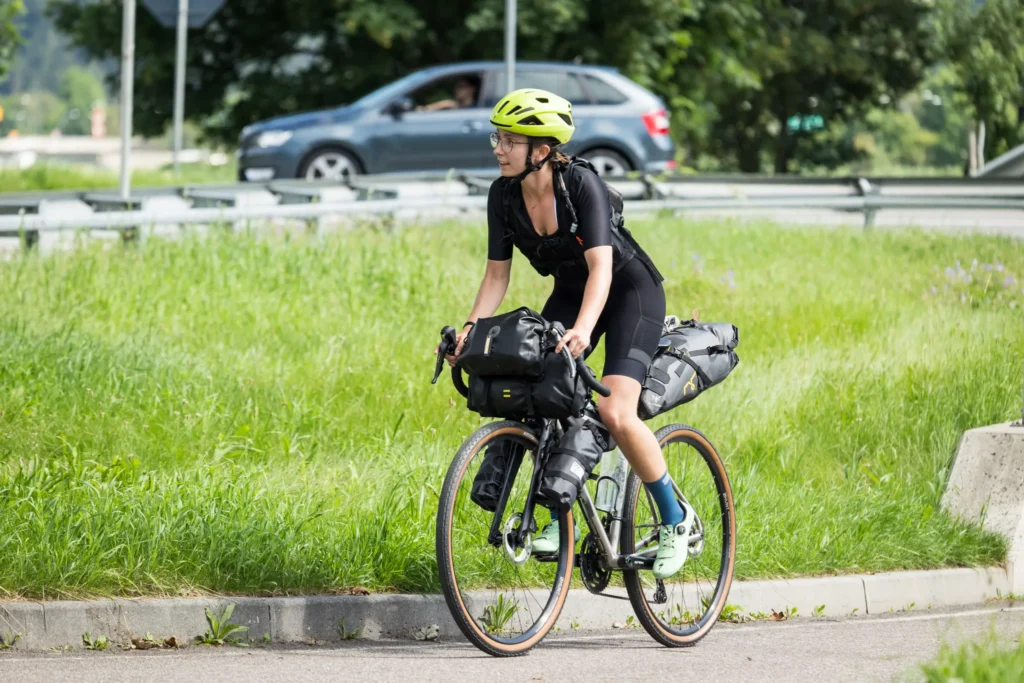How to travel sustainable with your bike

What if the journey begins before you get to the starting point? What if the adventure began before the event itself? Preparing for a bikepacking trip means opening yourself up to new experiences, new encounters, and new adventures, but before you start riding, there is a question to be solved: how to get to the starting point?
Train + bike: the best solution
If you are looking for a sustainable, comfortable and efficient way to get to your starting point without stress before tackling miles of trails and dirt roads, train is the perfect solution. A means of transportation that matches the philosophy of bikepacking: efficient and environmentally friendly travel. Let’s see what to keep in mind to make the experience stress free
How to plan your trip
As you prepare to reach the starting point of your adventure, consider these simple but useful tips:
- Choose a strategic train station Identify the nearest train station to the starting point of your route or event you need to get to, and remember that you have your bike with you, so even a station 15-20 km away will do just fine, you can get off the train and start pedaling.
- Hours and connections Plan your arrival time carefully, check schedules to avoid downtime or connections that are too tight. If you can, choose to travel away from peak times so your trip will be more enjoyable. The goal is to arrive rested and ready to go.
- Book early In some cases, reserving space for you and your bike is mandatory. Especially during peak season or if you are participating in a popular bikepacking event, secure your spot well in advance.

How to integrate the bike
Most train companies offer the option of traveling with your bicycle. Some require you to reserve a specific seat for your bike, others allow you to load it directly into the carriage, but the main thing is that you and your bike travel together. Before you leave, be sure to check local rules for bike transportation on trains so you can avoid surprises. Further down in this article you will find examples from some European countries.
Management of bikepacking bags on the train and safety
There are three possible solutions for storing your bike on the train: hanging, horizontally or in a bag. But we If the weight is not excessive and the journey does not exceed 5 hours, we can keep the saddle bag and the frame bag attached to the bike, but we recommend removing the one on the handlebar and on the fork because stimulating these parts too much is not the best position vertical.
On some trains, they will explicitly ask to remove the bags, all of them. When should it be done? The conductor decides. We advise you to arrive early on the platform, locate a staff member and ask. Cyclists with bags always receive sympathy, so they may favour you if you approach them with a smile and kindness. travellers have one more problem: bags.

If, on the other hand, you are delayed, we recommend that you quickly remove everything and arrange the bags as if they were suitcases in the spaces of the train. Regarding security, we advise you never to trust that your bike will be safe when out of sight. In general, we choose a seat that allows us to have a direct line of sight with our bike at all times.
Bicycle + train: the main options
Each European country has its own specific rules for transporting bicycles on trains, so it is important to know your local regulations before you travel. Below is a guide, based on our experience, on how to get around with train + bike in Europe.
- Regional Trains (R) These are the most frequent and accessible trains for bicycle travelers. In many countries these regional trains allow you to bring your bike without major restrictions. There is often a dedicated carriage with space for bikes, and the cost of carrying a bike is modest or even free.
- Long-distance trains (IC, EC). These trains, such as the InterCity (IC) and EuroCity (EC), cover longer distances and often connect large cities. In most cases, they allow bicycle transportation, but you must reserve a place for your bike in advance. Costs vary by country and rail company.
- High-speed trains (TGV, ICE, AVE, Eurostar) High-speed trains such as the TGV (France), ICE (Germany), AVE (Spain) and Eurostar (connecting the UK and France) are the fastest but also the most complex option for bicycle transportation. On many of these trains, bicycles must be disassembled and packed in a special bag (generally maximum size 120×90 cm).
Main rules for bike transportation in some European countries (to be checked before you go)
France
Offers good options for traveling by bike on regional TER trains, where bike transport is often free. On TGV trains, you need to reserve a seat for your bike in advance, which usually has an additional cost of about €10. If there is no space available, you will have to pack and disassemble it.
Italy
You can safely travel with your bicycle on regional Trenitalia trains by paying an additional ticket (about 3.50 € for a day). On long-distance trains such as the InterCity , you are required to pay an additional fee and reserve a bike seat, which specifically will be on carriage number 3, so remember to reserve your seat in the same, to travel next to your bike. On Frecciarossa and Frecciargento trains, however, the bike must be disassembled and placed in a bag.
Germany
One of the most bike-friendly countries in Europe. On regional trains (DB Regio), you can bring your bike by purchasing an additional ticket (often between €4-6), and there are special carriages for bicycles. On ICE (high-speed) trains, bicycles must be disassembled and packed, but on IC and EC trains, you can travel with the whole bike as long as you reserve a seat for it.
Netherlands
Home of bicycles, offers an excellent infrastructure for bike transportation. On NS (domestic) trains, you can bring your bike, but only outside of rush hour (weekdays). The cost to transport the bike is about €7.50 for a full day. Folding bicycles travel free of charge.
Slovenia
You will probably arrive in Slovenia with a DB or OBB or even Trenitalia train (to and from Trieste), but if you want to move within Slovenia, you will have to check train by train (therefore not only according to the route) if the model you will find has the space dedicated to the bike. The cost of the ticket is €1.50. Austria
The main railway company is the ÖBB (Österreichische Bundesbahnen), which offers several options for traveling by bicycle. Reservations are required on OBB trains . You can take your bike on practically any train, and the cost each way is €3. The selection is very simple: when you look for a ticket on the OBB website, add the bike ticket to yours, and it will only show you the trains available for the transport of your two-wheeler. Attention: OBB also manages buses, especially from Italy, and it is possible to bring the bike on these vehicles but in practice, there is at most room for two bicycles.

The journey is already part of the adventure
Choosing the train to get to the starting point of a bikepacking event is not only a practical decision, it is also the perfect way to consciously and respectfully enjoy the entire experience, from the planning to the last mile traveled.
All you have to do is choose your next destination and get ready to go!
Fantastico,grazie per i consigli sempre ben accetti e ricchi di informazioni utili.😊


Add comment